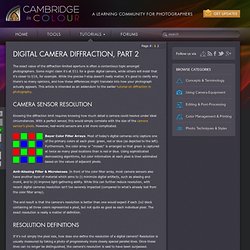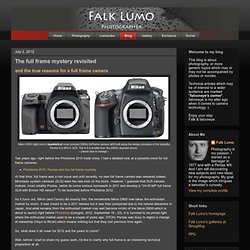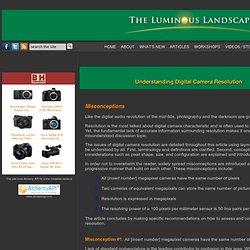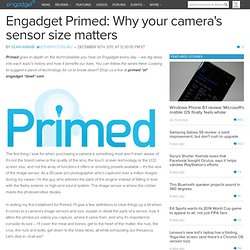

Myths About Megapixels (...And, Does the D800 Have Too Many?) By Ctein The recent announcement of the 36-megapixel Nikon D800 has brought forth a certain number of predictable reactions, a few lauding it as the Second Coming and many more dismissing the utility of more megapixels.
Most such opinions are based on mythical (or at least mistaken) beliefs about what pixel counts really mean. Let's see how many of them I can shoot down in one column. Digital Camera Diffraction – Resolution, Color & Micro-Contrast. The exact value of the diffraction-limited aperture is often a contentious topic amongst photographers.

Some might claim it's at f/11 for a given digital camera, while others will insist that it's closer to f/16, for example. While the precise f-stop doesn't really matter, it's good to clarify why there's so many opinions, and how these differences might translate into how your photograph actually appears. This article is intended as an addendum to the earlier tutorial on diffraction in photography.
Knowing the diffraction limit requires knowing how much detail a camera could resolve under ideal circumstances. With a perfect sensor, this would simply correlate with the size of the camera sensor's pixels. Bayer Color Filter Arrays. Anti-Aliasing Filter & Microlenses. Full Frame DSLR Cameras Part I – Nikon vs Sony. By Ray Fontaine This is a three part blog series on full-frame (FF) format cameras.

Part I reviews Nikon and Sony’s relationship, Part II will discuss Canon’s FF product strategy, and Part III will address new entrants to the sector and speculation on the future of FF format cameras. Part I: Nikon vs. Do Sensors “Outresolve” Lenses? We read everywhere that new high resolution sensors put pressure on actual lenses.

These comments arise copiously each time a new sensor with higher pixel counts appears. It happened with the 22 millions of pixels of the Canon 1Ds Mark III, and it will happen again when the 25 MP sensor by Sony comes to life into a new camera. Are this kind of comments accurate? There is no short answer to the question, because the subject is complex. However, we will try to summarize several basic rules and results, closing a previous discussion at The Luminous Landscape. Lens resolution basics To begin with, a bit of terminological precision will be handy. The modulation transfer functions (MTF) are a far more complex objective measure of image quality, and it combines resolution and contrast. Lens resolution is limited by diffraction, when you close the diaphragm, and by aberrations, which worsen with focal length and the opening of the diaphragm.
Figure 2. True reasons for Full Frame. The true reasons for a full frame camera – White Paper – LumoLabs: Camera equivalence. Various parameters, or variables of a real camera or a reference camera are depicted above In preparation of an article discussing the advantages and disadvantages of various sensor sizes for a given camera performance, I try to set a common ground for such discussions.

I have prepared a white paper which dives much deeper into the topic than is possible in this short blog article. You may find it here: The short version is this: An image contains no information whatsoever about the size of the sensor within the camera which was used to capture it. None. The full frame mystery revisited. And the true reasons for a full frame camera Two years ago, right before the Photokina 2010 trade show, I had a detailed look at a possible trend for full frame cameras:Photokina 2010, Pentax and the full frame mystery At that time, full frame was a non issue and until recently, no new full frame camera was released indeed.

Mirrorless system cameras (SLD) were the new kids on the block. However, I guessed that SLR camera makers, most notably Pentax, better do some serious homework in 2011 and develop a "24-35 MP full frame SLR with Exmor HD sensor". To be launched before Photokina 2012. As it turns out, Nikon (and Canon) did exactly this: the remarkable Nikon D800 now takes the enthusiast market by storm. Megapixels - Learn - Snapsort. Short Description Camera with the highest megapixel rating The Sony A7R has the highest claimed resolution of any camera we've seen at 36.2 MP.
Resolution is a rating of the total number of pixels used by the camera image sensor to capture the photograph. For example if the camera utilizes a 4000x3000 pixel image sensor the total number of pixels is 12,000,000 or 12 million pixels. True resolution - Learn - Snapsort. Do Megapixels Tell the Whole Story?

14 Megapixel SLR vs 14 Megapixel Digicam. Res-Demyst. By: JR GEOFFRION Misconceptions Like the digital audio revolution of the mid-80s, photography and the darkroom are going digital.

Resolution is the most talked about digital camera characteristic and is often used to describe image quality. Yet, the fundamental lack of accurate information surrounding resolution makes it one of the most misunderstood discussion topic. Primed: Why your camera's sensor size matters. Primed goes in-depth on the technobabble you hear on Engadget every day -- we dig deep into each topic's history and how it benefits our lives.

You can follow the series here. Looking to suggest a piece of technology for us to break down? Drop us a line at primed *at* engadget *dawt* com. Optimizing Exposure. Why Do Camera Makers Give Us19th Century Exposures With Our 21st Century Cameras? Lace and Forest. Clearview, Ontario. July, 2011 Fuji X100 @ ISO 400 A Bit of Background Information. Digital Camera Sensor Sizes: How it Influences Your Photography. This article aims to address the question: how does your digital camera's sensor size influence different types of photography? Your choice of sensor size is analogous to choosing between 35 mm, medium format and large format film cameras — with a few notable differences unique to digital technology. Much confusion often arises on this topic because there are both so many different size options, and so many trade-offs relating to depth of field, image noise, diffraction, cost and size/weight.
Background reading on this topic can be found in the tutorial on digital camera sensors. Sensor sizes currently have many possibilities, depending on their use, price point and desired portability. The relative size for many of these is shown below: Does Pixel Size Matter. By Roger N. Clark All images, text and data on this site are copyrighted. Clarkvision.com: Night and Low Light Photography with Digital Cameras. By Roger N. Clark All images, text and data on this site are copyrighted. They may not be used except by written permission from Roger N. Clark. All rights reserved. Digital Camera Sensor Performance Summary. DSLR APS-C versus 35 mm sensors. When I started working with Canon's EF-lens compatible digital SLRs (DSLRs) -- the line including the Digital Rebel / EOS 300D, Digital Rebel XT / EOS 350D, EOS 20D, Digital Rebel XTi / EOS 400D and EOS 30D -- I constantly came across this factor "1.6.
"